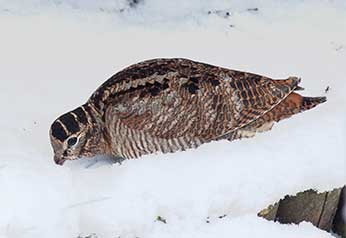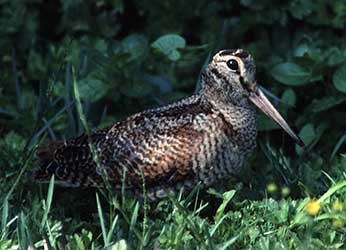Woodcock (Scolopax rusticola)
When: All through the year
How many: Moderate numbers

patterned plumaged, and long bill
specially evolved for reaching deep down
into mud (and snow)
The woodcock is a rather unusual bird. Plump, barrel-chested, long-billed creatures, woodcock are most at home in extensive tracts of damp, broad-leaved woodland.
Perhaps not surprisingly, woodcock are relatively widespread in the New Forest, at least, that is, as breeding birds, for at other times they are so secretive that it’s difficult to guess the extent to which they’re present. It is known, however, that in autumn, large numbers arrive in Britain from central and northern Europe, so it is reasonable to assume that many of these are tempted to stay in the New Forest.
Superbly cryptic, intricately patterned rich-brown plumage makes the woodcock incredibly difficult to see on the ground – the first awareness of a feeding or resting woodcock is usually as it explodes upwards with a flurry of wing-beats, then zigzags away between the trees before reaching open space and heading upwards through the canopy, and out of sight.
Widely spaced eyes provide the woodcock with excellent all-round vision, which is probably just as well for such is the erratic nature of the bird's flight that these harmless, idiosyncratic creatures are favourite targets of shooters stimulated by the ‘Woodcock challenge’.
Late winter and spring are the best times to see woodcock for then, in the twilight hours, the males perform display flights – known as roding - above or amongst the treetops. Following a wide circuit of the woods on broad, rounded, owl-like wings, Woodcock often use woodland rides as route markers whilst alternately croaking like demented frogs and uttering repeated, high pitched ‘tsiwick’ calls.
Roding woodcock are often first seen 20 minutes, or so, after sunset, their appearance often coinciding with the first, tentative calls of tawny owls. Display usually ceases 30-45 minutes later, before being repeated again immediately before sunrise.
Commencement of the roding season seems to be heavily influenced by weather. In the New Forest, woodcock roding often starts at the beginning of March, or exceptionally in February, yet in 2006 after a quite prolonged cold spell, woodcock did not really start to rode until early April, and even then took a while to seriously go about their breeding season business.
But despite this prominent display flight, it is always difficult to accurately assess the number of woodcock present, for roding males do not in the conventional sense hold territory. Rather, they rode over a relatively wide area in an effort to tempt females up to join them, or, alternatively, to encourage females on the ground to reveal themselves.

side of the head, which provides good all-round vision
Woodcock nests are little more than shallow depressions concealed amongst the undergrowth, sparsely lined with dead leaves, dried grass and, maybe, a few feathers.
Clutches of four eggs are about average, and the young hatch after around 22 days, complete with a covering of down, and are immediately mobile. They fledge after a further 15-20 days.
Diet is made up of earthworms and other woodland invertebrates that are captured whilst the birds probe the damp ground with long bills specially evolved for the purpose, or are taken from amongst the leaf litter.
References:
The Shell Guide to the Birds of Britain and Ireland: James Ferguson-Lees, Ian Willis and J.T.R. Sharrock
Handbook of the Birds of Europe, the Middle East and North Africa, The Birds of the Western Palearctic (volumes 1-9): Stanley Cramp, et al
The Birds of the Western Palearctic, Concise Edition: D.W. Snow and C.M. Perrins
More links
Other related links
Search this site

Sadly, 58 animals were killed - 35 ponies, 13 cows, 8 donkeys and 2 sheep, whilst a further 32 were injured - 3 pigs, 9 donkeys, 11 cows and 9 ponies.
(Forty-three accidents occurred in daylight, 15 at twilight and 101 in the dark. Twenty-seven accidents were not reported by the driver involved).
Here's just one horrific example - Three donkeys killed in collision with van at notorious New Forest blackspot (Advertiser and Times)

